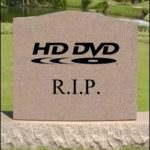This is a continuation of my previous articles: The Format was Media (Part1) and The Format was Media (Part2)
In my previous writeups on the format wars, all the competing formats that I have talked about have eventually gone the way of the dinosaurs. In this section, however, we tackle the topic of the most recent format war between 2 competing high storage optical media. The tech blogosphere was abuzz about this fiercely competitive duel in the mid 2000s and it is fairly recently that a victor has emerged. Yes, we’re talking about the now legendary Blu Ray vs HD DVD battle.
The DVD has reigned supreme in the home video domain since the late 90s and continues to hold on to its crown to this day, but it was only a matter of time before some of its shortcomings became apparent. This was illustrated more acutely with the advent of the LCD and Plasma HDTV’s which are capable of displaying high definition content. So how is that a problem for the DVD? Well here goes the explanation:
DVD stores video usually using MPEG-2 compression at up to 9.8 Mbit/s. This produces a max video resolution of 720 × 576 pixels and results in a maximum file size of 4.7Gb (single layer) depending upon the duration. Dual layer DVD’s can effectively store 9GB of data. Enter HDTV and these calculations go out of the window. With a native resolution of 1920×1080 pixels for full HD and 1368 x 720 pixels for basic HD, with 5 channel surround sound thrown in for good measure, it becomes apparent that file sizes to handle such video will shoot up exponentially and hence a super dense optical medium capable enough of storing huge files became the call of the hour.
People may be now familiar with the Blu-Ray disc used in Sony PlayStation 3 and in other commercial video players, The term comes from the fact that these recorders and media utilise a blue laser diode. While a standard DVD uses a 650 nanometer red laser, Blu-ray Disc uses a shorter wavelength 405 nm laser, and allows for almost ten times more data storage than a DVD.
It was in the mid 90’s that Sony started two projects applying the new diodes: UDO (Ultra Density Optical) and DVR Blue together with Philips, a format of 
At around the same time, another rival blue laser based format was being spawned known as HD-DVD, and the project was spearheaded by Toshiba and NEC.
The difference between storage capabilities of the two formats are as follows :
| 12cm Discs | HD-DVD | Blu Ray |
| Single Layer Capacity | 15Gb | 25Gb |
| Dual layer Capacity | 30gb | 50gb |
| 8cm Mini Discs | HD-DVD | Blu Ray |
| Single Layer Capacity | 4.7Gb | 7.8Gb |
| Dual layer Capacity | 9.4Gb | 15.6Gb |
By August 2007, HD DVD appeared to have a promising future, was seeing its highest sales (though still substantially lower than Blu-ray), had support from major big-box retailers such as Wal-Mart due to low prices, and had the exclusive support of studios such as Paramount Pictures, DreamWorks SKG/Animation, Universal Studios and several Indie film studios. The format also had non-exclusive though favorable support (through occasional HD DVD exclusive titles) from Warner Bros., the largest home video releaser.
Use in Videogame Consoles

Decline of HD-DVD
The tipping point came on January 4, 2008 when Warner Bros., which has the largest market share of DVDs, announced plans to drop HD DVD support completely as of the beginning of June 2008. Warner Bros.’ sister studio New Line Cinema followed suit, canceling tentative plans to release titles on HD DVD. Other small studios and producers moving exclusively to Blu-ray included National Geographic Society, Constantin Film, and Digital Playground
On February 19, 2008, Toshiba announced it would cease developing, manufacturing and marketing HD DVD players and recorders. On that same day, Universal Studios announced it would release its titles in the Blu-ray Disc format, following two years of exclusive HD DVD support.
Sony lost it’s first major format war with the Beta, but with the Blu Ray, it has finally triumphed.


